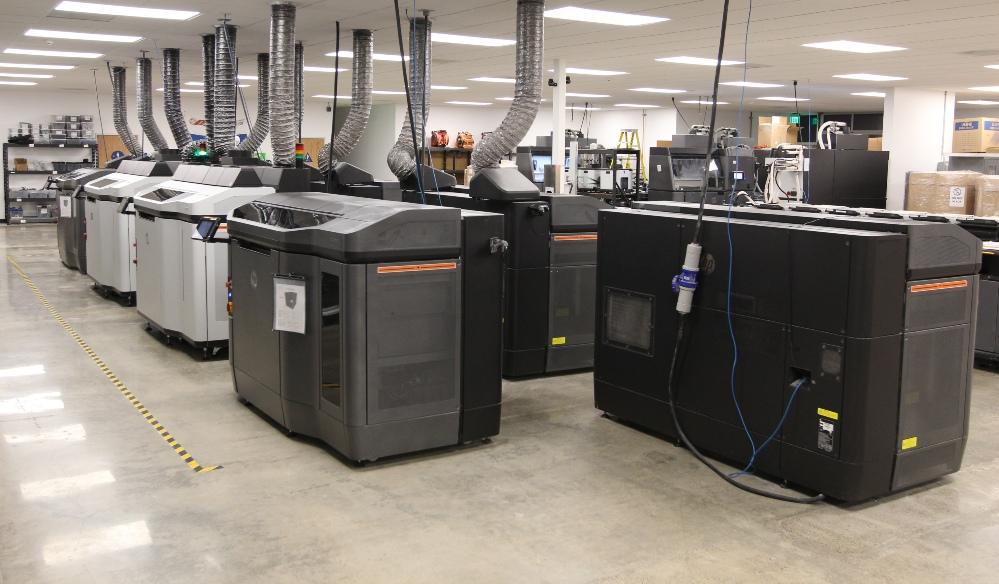- FMA
- The Fabricator
- FABTECH
- Canadian Metalworking
Our Publications
Categories
- Additive Manufacturing
- Aluminum Welding
- Arc Welding
- Assembly and Joining
- Automation and Robotics
- Bending and Forming
- Consumables
- Cutting and Weld Prep
- Electric Vehicles
- En Español
- Finishing
- Hydroforming
- Laser Cutting
- Laser Welding
- Machining
- Manufacturing Software
- Materials Handling
- Metals/Materials
- Oxyfuel Cutting
- Plasma Cutting
- Power Tools
- Punching and Other Holemaking
- Roll Forming
- Safety
- Sawing
- Shearing
- Shop Management
- Testing and Measuring
- Tube and Pipe Fabrication
- Tube and Pipe Production
- Waterjet Cutting
Industry Directory
Webcasts
Podcasts
FAB 40
Advertise
Subscribe
Account Login
Search
On-demand manufacturer has no plans to ‘hunker down’ during COVID
San Diego digital manufacturing company GoProto has been busy acquiring businesses and increasing its 3D printing capacity
- By Holly B. Martin
- February 19, 2021
- Article
- Additive Manufacturing

GoProto recently acquired two Australian facilities. A member of the Australian team prints clips from PA12 nylon. Images: GoProto
Additive Report: With all the recent activity at GoProto, it looks like the company has not hunkered down waiting for the world to return to normal.
Jesse Lea: You cannot do that. With COVID-19 suddenly changing the way parts and products are designed and manufactured, we’ve been right there to handle that change with digital manufacturing.
Digital is key to our business growth. It’s designed to handle new inputs and be flexible and fast, and it can adapt to everything from quick changes in part design to supply chain reshoring back to the U.S. We’ve had to jump in and attack with an adaptable business model to help those customers who still needed parts made throughout the pandemic. In fact, for a lot of them, their product development sped up because they had to change the products they offer.
AR: How did GoProto get started?
Lea: The five founding members have been in product design and development for 20 or 30 years. Over that time, the industry changed a lot and various companies of ours were acquired or merged. After our last venture, we got together in October of 2016 and started GoProto. So we’re a fairly young company, but we come with a long history of industry knowledge.
Our experiences in the past were similar to our business model now, which is rapid manufacturing using the latest technologies available, including a lot of 3D printing. So when we started GoProto, we jumped back into that and added new technologies, such as HP MJF, which we’ve aggressively pursued.
AR: Why are you so bullish on Multi Jet Fusion?
Lea: Where some other technologies, like the photopolymer 3D printing processes, make parts with nice surface finishes and good tolerances, the materials themselves aren’t intended for production. MJF is a different tool in the toolbox. It’s allowed us to use digital manufacturing for higher quantities of parts and faster, more production-like applications.
AR: Tell us about the shuttle bus retrofit the company did for The Seattle Children’s Hospital.
Lea: At the beginning of COVID, the hospital decided to put in plexiglass dividers to create a protected space for shuttle drivers. But to fix the plexiglass to the ceiling and the floor, they needed to custom-design and manufacture parts that would be strong enough to withstand the vibration and the force of a rider accidentally pushing against the plexiglass.
Using MJF technology to print black nylon PA12 material, we were able to quickly and inexpensively make parts strong enough to survive a real-life application—something that would have been a struggle to do in the past. And since we were able to machine the metal brackets and plexiglass panels as well, the combination of technologies made for a great solution that fits GoProto’s end-to-end solutions business model.
AR: What types of parts can you print using the new TPA (a material co-branded by Evonik and HP)?
Lea: We offer a parts service (3DElastoPrint) featuring a production-ready elastomeric TPA, which is an exciting new elastomer rubber material with high energy return and tear resistance but very low fatigue. While it does have limits, it’s more durable than other 3D-printed elastomer materials on the market now. A lot of the others perform well but will break down under exposure to UV light, chemicals, or higher or lower temperatures and become brittle over time. It’s ideal for applications like ducting and bellows, sportswear, and end-of-arm tooling.
AR: How does GoProto approach finishing parts for product development?
Lea: In our collective history, we’ve done a lot of model building where clients need something that looks, feels, and sometimes performs like an actual finished product. Something that can be used for marketing or testing, or even end production. Our ability to finish parts is an important piece of that process.
In some cases, we use a smoothing machine that exposes parts to a vaporized solvent that reorders the surface molecules to give them a nice semi-glossy finish. At the same time, it improves the parts’ elongation, so they handle impact and bending better.AR: Do you see additive displacing overseas production?Lea: For a lot of projects, additive augments injection molding done overseas. It works well as a bridge between low volumes and medium or high volumes of parts and for getting production-like parts fast while tooling is being created. And then, once tooling is ready, we phase in injection molding. Additive also allows you to make parts you couldn’t make with traditional injection molding—complex geometries with undercuts and lattices. In those cases, 3D printing is the production solution, and the part never would have gone to injection molding.AR: Will GoProto continue its aggressive growth trajectory through 2021?
Lea: I think digital additive manufacturing is going to be explosive, because the technologies are becoming more usable. We have a long history of production manufacturing, design for manufacturability, management through the project, and quality control and process control through production.
The same principles are applied to additive manufacturing. We’re positioned to take on the big demands that folks are putting on these systems. It should be a big growth year for the whole industry.
About the Author

Holly B. Martin
About the Publication
- Podcasting
- Podcast:
- The Fabricator Podcast
- Published:
- 04/16/2024
- Running Time:
- 63:29
In this episode of The Fabricator Podcast, Caleb Chamberlain, co-founder and CEO of OSH Cut, discusses his company’s...
- Trending Articles
- Industry Events
16th Annual Safety Conference
- April 30 - May 1, 2024
- Elgin,
Pipe and Tube Conference
- May 21 - 22, 2024
- Omaha, NE
World-Class Roll Forming Workshop
- June 5 - 6, 2024
- Louisville, KY
Advanced Laser Application Workshop
- June 25 - 27, 2024
- Novi, MI




























